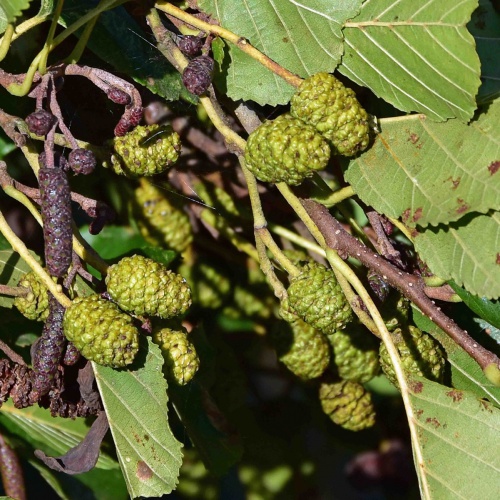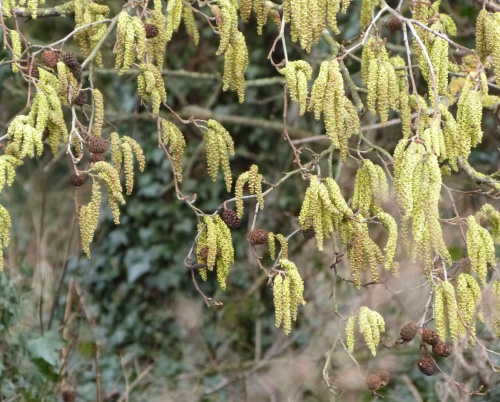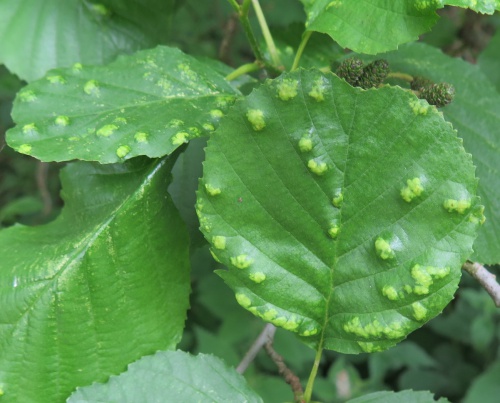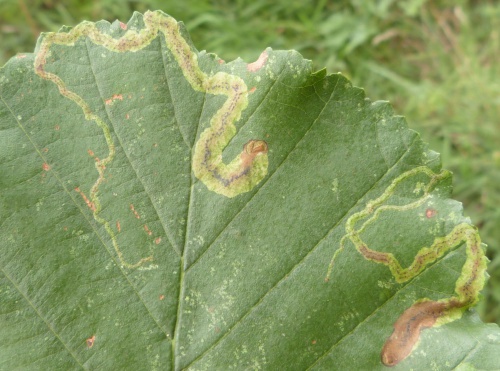Alder - Alnus glutinosa
Tree or shrub to 20m. Leaves roundish, blunt ovate. Dark brown fissured bark on mature trees. Male catkins yellow, female flowers purplish, appearing before the leaves. Fruiting catkins cone like.
Alnus incana and other non-native alders are very similar when not in leaf.
When in leaf, Alnus glutinosa is unmistakable, but it is difficult to distinguish this species from other Alders from the winter buds, twigs, fruits, cones or catkins
Photos of leaves.
By water.
all year
Deciduous.
Fairly common throughout Britain.
Common by water in Leicestershire and Rutland, occasionally planted in drier areas. In the 1979 Flora survey of Leicestershire it was found in 287 of the 617 tetrads.
Leicestershire & Rutland Map
Enter a town or village to see local records
MAP KEY:
Yellow squares = NBN records (all known data)
Coloured circles = NatureSpot records: 2020+ | 2015-2019 | pre-2015
UK Map
Species profile
- Common names
- Alder
- Species group:
- Trees, Shrubs & Climbers
- Kingdom:
- Plantae
- Order:
- Fagales
- Family:
- Betulaceae
- Records on NatureSpot:
- 307
- First record:
- 11/05/1992 (John Mousley;Steve Grover)
- Last record:
- 04/05/2024 (Carter, Robert)
Total records by month
% of records within its species group
10km squares with records
The latest images and records displayed below include those awaiting verification checks so we cannot guarantee that every identification is correct. Once accepted, the record displays a green tick.
In the Latest Records section, click on the header to sort A-Z, and again to sort Z-A. Use the header boxes to filter the list.
Latest images
Latest records
Alder Leaf Beetle
Agelastica alni is a distinctive, dark metallic blue coloured species measuring around 7mm in length. It feeds mainly on Alder but is occasionally found on other deciduous trees such as Beech, Hazel and Hornbeam. The black larvae can be found in July and August when they can cause significant leaf damage.
Eriophyes laevis
The mite Eriophyes laevis causes galls to form on the leaves of Alder (Alnus glutinosa). The galls start off shiny yellow, becoming green then red, purplish or brown. They are scattered over the leaf, often numerous, and with a small opening below. The gall is seen more often than the mite.
Acalitus brevitarsus
Acalitus brevitarsus is a mite that causes blister like galls to form on the leaves of Alder. Like many mite galls, the leaf is made to grow clusters of hairs, called erineum, among which the mites live. On the underside of the leaf these galls have a shiny pale brown appearance. The galls are seen more often than the mite.
Aceria nalepai
A gall mite which causes pouch galls to form on the leaves of Alder, in the angles between the midrib and the primary veins. They appear either alternately or in pairs and may run from the petiole to within two or three veins of the leaf apex. The galls are filled with russet hairs amongst which the mites live, and these hairs often project through to the underside of the leaf to form more or less triangular patches.
Agromyza alnivora
The larvae of this fly mine the leaves of various species of Alder creating an upper surface gallery, narrow at first but widening considerably towards the end. Frass is typically in two rows.





























